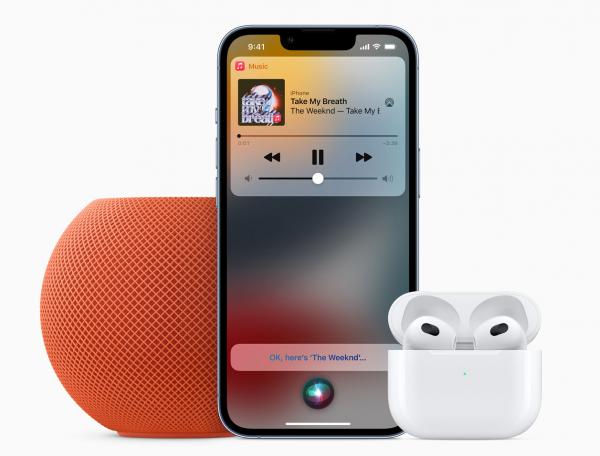Apple Introduces New Music Plan, AirPods, and HomePod Mini

The Apple Music Voice Plan is $5 per month (compared to the individual full plan at $10 per month) and will be available later this fall. It works similarly to Amazon Music’s Echo plan at $4 per month, where Echo or Fire TV users can play music through their devices.
While users will get access to the entire catalog of 90 million songs and 30,000 pre-made playlists created by Apple Music’s editorial staff, the user interface is pared-down. Voice Plan subscribers can only interact with Apple Music’s catalog using Siri voice commands. There will be a dedicated section called “Just Ask Siri” with tips for getting Siri to do what you want.
You won’t see albums or suggestions on the screen. The Apple Music app will have a list of voice commands and recently played tracks. Users can ask Siri to play a mood or activity playlist like “Play dinner music,” “Play something chill,” or “Play more like this.” The Voice Plan also includes personalized mixes and genre stations, as well as Apple Music Radio. Note that these new playlists are available to all Apple Music subscribers. The Apple Music Voice plan can be accessed by all Apple devices—iPhone, iPad, AirPods, CarPlay, Apple Watch, Apple TV, Mac, and HomePod mini.
Subscribe to the Apple Music Voice Plan through Siri by saying, “Hey Siri, start my Apple Music Voice trial,” or signing up through the Apple Music app. There is a seven-day free trial without auto-renewal.
Next Generation of AirPods
While the newly announced AirPods are being called the “3rd Generation AirPod,” it’s really an upgrade from the original AirPods. The new model is adopting features that used to be exclusive to the AirPod Pros. Both the earbuds and the charging case have IPX 4 sweat and water resistance. Like the Pros, the new AirPods are capable of spatial audio with dynamic head tracking.
Although an upgrade to the original AirPods, they have a shorter stem like the Pros. They also have a force sensor for easier touch control. The previous AirPods have optical sensors, so it knows when the earbuds are in your ears. The new AirPods have a new skin-detect sensor so it knows when it’s in your ears, not sitting on the desk, and will pause the music when you take them out.
Apple has improved the AirPods battery life. Compared to the AirPod Pros’ 4.5 hours and 24 hours of listening time, the new AirPods’ battery lasts up to 6 hours with 30 hours of listening time with the charging case.
Many of the features and design from the AirPod Pros have been incorporated into this generation. Both have a custom high-excursion Apple Driver and high-dynamic-range amplifier. Their inward-facing microphones monitor the sound. Then, using Adaptive EQ powered by computational audio, it tunes the bass and mid-frequencies, adapting the sound to accommodate the earbuds’ fit in an individual’s ears. The result is clean high frequencies.
These AirPods can also be used while watching videos on an Apple TV, iPhone, iPad, or Mac for a surround sound-like experience. Spatial audio “places” sound around the room. Dolby Atmos delivers the best audio available. Capable of dynamic head tracking and advanced spatial audio algorithms, music, video, and Group FaceTime calls all have directional audio where instruments and sound keep their “place” in the room.
AirPods are multi-functional and can be used for calls and Siri voice commands. Beamforming microphones block out ambient noise to focus on the user’s voice. To further improve voice quality, the microphone is covered by an acoustic mesh to help reduce the sound of the wind. AirPods also feature the AAC-ELD speech codec for clear communication for FaceTime calls. Announce Notifications allows Siri to read important time-sensitive notifications, including alerts from Messages, Reminders, Calendars, and calls, as well as any third-party apps that adopt the API.
AirPods are now part of the Find My network of hundreds of millions of iPhone, iPad, and Mac computers around the world, offering proximity view in the Find My app and Lost Mode, as well as separation alerts and sounds.
The most significant difference between these AirPods and the AirPods Pro is that the Pros also have noise cancellation and Transparency mode.
At $179, the new AirPods are at the same price point as the original generation (now reduced to $129). Available for pre-order, the new AirPods will be in stores on October 26th.
HomePod mini
The HomePod mini was released a year ago to take the place of the Apple HomePod after it was discontinued last year. Apple announced that they are releasing three new colors in time for the holidays. The 3.3-inch tall speaker will now come in yellow, orange and blue as well as space gray and white.
The mini is a smart speaker that uses Siri voice commands to control the speaker and other smart home devices. It can control lights, lock doors, change the temperature, and more. It also works with “Find My” to locate devices and Apple AirTags. Siri on the HomePod mini pairs perfectly with Apple Music’s Voice Plan.
Siri recognizes up to six different voices in your household and will play music according to each individual’s habits as well as read their calendar, notes, and reminders. A three-microphone array listens for a user to say, “Hey Siri.” A fourth inward-facing microphone cancels out the music so it can hear and decipher Siri requests. Automatic Siri volume automatically adjusts the volume of Siri’s responses based on the room environment and how loud you are speaking.
Apple hopes that this diminutive speaker can perform like its big-brother predecessor. Massive amounts of research and testing was put into designing the original HomePod. Many of those design features are incorporated into the HomePod mini.
To further improve the sound, the HomePod mini uses computational audio similar to that used in the AirPods to tune the speaker to its environment. The Apple S5 chip analyzes the music to optimize loudness and adjust the dynamic range. It does this by controlling the movement of the full-range driver and neodymium magnet and the force-canceling radiators for deeper, fuller bass.
When paired with the Apple TV 4K, it constantly analyzes the audio and models its performance to reproduce the clearest dialog.
The speaker’s sound is directed down and out of the bottom of the 360-degree audio. No matter where you sit in the room, you can enjoy the same sound experience.
The HomePod mini is available now, with the new colors being released in November. It runs $99.





























































